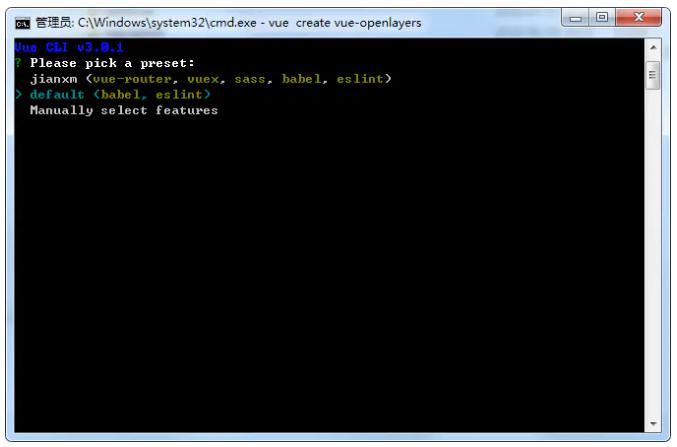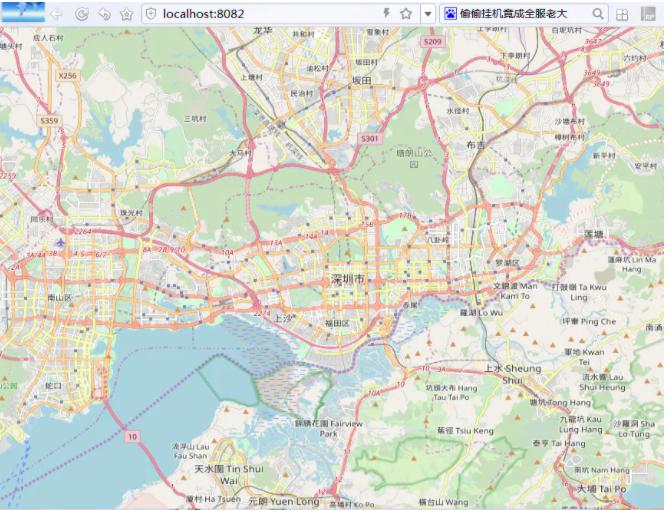Abstract: Use the latest vue-cli3.x 1.Install vue-cli3.0.1: https://cli.vuejs.org/guide/ Cnpm install-g @ vue/cli Vue-V View version 2.Creat...
Use the latest vue-cli3.x
1.Install vue-cli3.0.1: https://cli.vuejs.org/guide/
Cnpm install-g @ vue/cliVue-V View version
2.Create a new project vue create vue-openlayers, and select the default template

3.Run
Cd vue-openlayers
Npm run serve4.Open the project with vscode, open the terminal, and install openlayers Openlayers official website: http://openlayers.org
Cnpm I-S olDelete HelloWorld.vue
Create a new olmap.vue component (you can install vetur and vue vscode snippets plugins under the vscode editor to facilitate code hints and write vue code-vbase commands)
components/olmap.vue
<template>
<div id="map" ref="rootmap">
</div>
</template>
<script>
import "ol/ol.css";
import { Map, View } from "ol";
import TileLayer from "ol/layer/Tile";
import OSM from "ol/source/OSM";
export default {
data() {
return {
map: null
};
},
mounted() {
var mapcontainer = this.$refs.rootmap;
this.map = new Map({
target: "map",
layers: [
new TileLayer({
source: new OSM()
})
],
view: new View({
projection: "EPSG:4326", //use this coordinate system
center: [114.064839,22.548857], //Shenzhen
zoom: 12
})
});
}
};
</script>App.vue
<template>
<div id="app">
<olmap />
</div>
</template>
<script>
import olmap from './components/olmap.vue'
export default {
name: 'app',
components: {
olmap
}
}
</script>
<style>
*{padding:0; margin:0;}
html,body{
height: 100%;
}
#app {
height: 100%;
}
</style>5.Run npm run serve

6.Put some information into the configuration file, create a new config folder in the src directory, and build mapconfig.js src/config/mapconfig.js
Import TileLayer from "ol/layer/Tile"
Import TileArcGISRest from 'ol/source/TileArcGISRest'
Import OSM from "ol/source/OSM"
Import XYZ from 'ol/source/XYZ'
Let maptype=2 / / 0 represents the deployed offline tile map, 1 indicates OSM,2 indicates the use of the Arcgis online midnight blue map service
Var streetmap=function () {
Var maplayer=null
Switch (maptype) {
Case 0:
Maplayer=new TileLayer ({
Source: new XYZ ({
Url:' http://127.0.0.1:7080/streetmap/shenzhen/{z}/{x}/{y}.jpg'
})
})
Break
Case 1:
Maplayer=new TileLayer ({
Source: new OSM ()
})
Break
Case 2:
Maplayer=new TileLayer ({
Source:new TileArcGISRest ({
Url:' https://map.geoq.cn/ArcGIS/rest/services/ChinaOnlineCommunity/MapServer'
})
})
Break
}
Return [maplayer]
}
Var mapconfig= {
XRV 114.064839, / / longitude and latitude of the center point
Y:22.548857
Zoom:15, / / Map Zoom level
Streetmap:streetmap
}
Export default mapconfigsrc/components/olmap.vue make corresponding changes
<template>
<div id="map" ref="rootmap">
</div>
</template>
<script>
Import "ol/ol.css"
Import {Map, View} from "ol"
Import mapconfig from'.. / config/mapconfig'
Export default {
Data () {
Return {
Map: null
}
}
Mounted () {
Var mapcontainer = this.$refs.rootmap
This.map = new Map ({
Target: mapcontainer
Layers: mapconfig.streetmap ()
View: new View ({
Projection: "EPSG:4326", / / use this coordinate system
Center: [mapconfig.x,mapconfig.y], / / Shenzhen
Zoom: mapconfig.zoom
})
});
}
}
</script>
<style>
#map{height:100%;}
/ * hide some native elements of ol * /
. ol-attribution,.ol-zoom {display: none;}
</style>